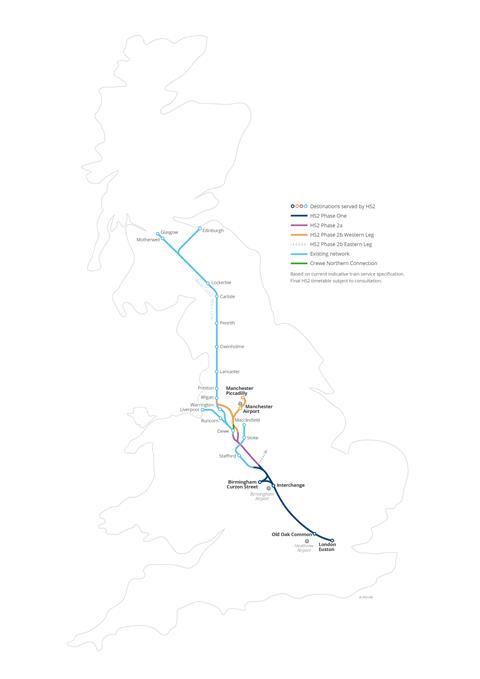
UK: A hybrid bill seeking approval to build a further 85 km of the High Speed 2 network linking Crewe with Manchester has been laid before parliament, the government announced on January 24.
This Phase 2b Western Leg will see a high speed station built at Manchester Airport and additional platforms constructed at Manchester Piccadilly to handle high speed services.
Parliament has already approved phases 1 and 2a of HS2, which will take the line from London Euston to Birmingham and Crewe, and construction of these is already underway. Once the route from London to Manchester has been completed, the journey time between the two cities will be cut from around 2 h 10 min today to approximately 1 h 15 min, while the Birmingham – Manchester journey time would be broadly halved.
The High Speed Rail (Crewe – Manchester) Bill also includes provision for remodelled junctions around Crewe, including the Crewe Northern Connection, which would provide a grade-separated link between HS2 and the West Coast Main Line north of the existing station. According to the Department for Transport, this would facilitate redevelopment of the station as ‘a mid-Cheshire hub’, allowing more high speed and conventional services to serve the town.
Integrated Rail Plan
The recent publication by the government of its Integrated Rail Plan for the North & Midlands and of Sir Peter Hendy’s Union Connectivity Review has led to significant revision of plans for HS2, and this is reflected in the latest hybrid bill.

The bill includes passive provision for a series of junctions which would support east-west journeys across northern England. Under IRP, short sections of new line are envisaged to link Warrington with Manchester Airport and Manchester Piccadilly with Marsden west of Huddersfield.
In light of UCR, previous plans for HS2 to continue north from Crewe to rejoin the WCML at Bamfurlong south of Wigan are expected to be reassessed to optimise Anglo-Scottish journey times; this section of HS2 is not covered by the latest parliamentary submission.
Released capacity
The existing routes between Crewe, Stoke, Stockport, Manchester Airport and Manchester Piccadilly are among the most operationally complex on the UK network. According to project promoter HS2 Ltd, ‘up to three new train paths per hour could be released between Crewe and Manchester via Stockport, and the number of seats on services between Crewe, Stoke-on-Trent and Manchester Piccadilly could more than double during the evening peak’ as inter-city services move to the dedicated line.
‘Today marks the next chapter in fulfilling the promises in our £96bn Integrated Rail Plan to shorten journey times, provide reliable and sustainable services, while supporting local services and delivering a modern, fully connected transport network fit for the future even sooner’, commented HS2 Minister Andrew Stephenson.
Reactions
Policymakers and transport officials across northern England remain highly critical of the government’s decision to scale back the vision for HS2 and Northern Powerhouse Rail in its IRP. In particular, the decision to push ahead with developing Manchester Piccadilly with six terminus platforms rather than as a low-level through station remains a major bone of contention.
‘Building HS2 on the surface at Piccadilly means the new station will be at full capacity from day one. It means the new services from Liverpool and Leeds having to reverse out. And it also means forever losing prime development land and the economic opportunity that goes with it’, said Greater Manchester Mayor Andy Burnham on January 24.
Building #HS2 on the surface at Piccadilly means the new station will be at full capacity from day one. It means the new services from Liverpool & Leeds having to reverse out. And it also means forever losing prime development land and the economic opportunity that goes with it. https://t.co/CD1ysIIkmI
— Mayor of Greater Manchester Andy Burnham (@MayorofGM) January 24, 2022
Other respondents urged the government to provide more detail on its IRP proposals, especially regarding the descoped Eastern Leg of HS2 between Birmingham, Leeds and York, most of which will now not be built.
Welcoming the latest bill’s progress to parliament, Darren Caplan, Chief Executive of the Railway Industry Association, said that it was ‘rail businesses up and down the country stand ready to support this transformational project, supporting jobs and investment whilst delivering a new sustainable railway for the nation.
‘Of course, this development should be accompanied by a commitment to deliver the HS2 Eastern Leg too — only by delivering the full scheme will all the benefits of HS2 be realised. So we continue to urge the government to develop the Birmingham to Leeds stretch of HS2 at the same time as pushing on with the Western Leg to Manchester.’
‘This is another watershed moment in the future of our high speed railway’, added Maria Machancoses, CEO of Midlands Connect. ‘This extension of HS2 from London and Birmingham to Manchester will give the West Midlands and North West the fast, reliable rail connectivity these regions so desperately need. While it’s great news that the Western Leg of HS2 is moving forward with pace, the Eastern Leg of HS2 from the Midlands to Yorkshire and the northeast is still vitally important. We’re working with government to feed into its study into how to best connect these areas.’



